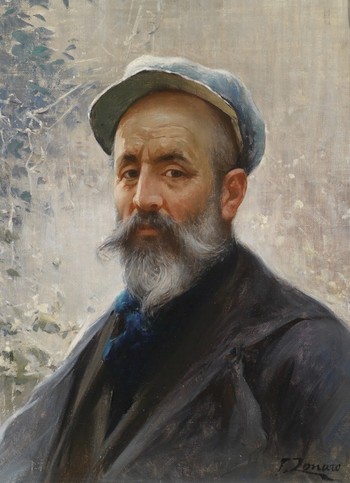© Turkuvaz Haberleşme ve Yayıncılık 2024
Professor Fatma Ürekli, head of Mimar Sinan Fine Arts University's Department of History, focuses on the life of Fausto Zonaro, who wanted to paint the portrait of Abdülhamid Han II after he was dethroned in his last year. "Zonaro informed the Sultan of this will of his. And finally convinced him. As far as we know, Zonaro is the only painter who painted the portrait of the sultan," said Ürekli.
Ürekli's book, "Sarayın Son Başressamı Fausto Zonaro - İkbalden İdbara" (The Last Chief Painter of the Place - From Luck to Constraint), published by Türkiye İş Bankası Culture Publications, focuses on the life of Fausto Zonaro, who was the palace painter during the times of Abdülhamid II for 14 years and was removed from duty after the sultan was dethroned.
Ürekli focuses on the unknown parts or facts that are incorrectly known about the life of Italian painter Zonaro's life and also sheds light on different aspects of the sultan's times.
Speaking to Anadolu Agency (AA), Ürekli noted that she mostly works on the times, education, culture, arts and art institutions of the 19th century, Abdülhamid Han's periods.

She started her research after she encountered a petition of Zonaro dated 1909 and added that after Abdülhamid II was dethroned, the painter had no job and all his rights and privileges were taken from him.
Ürekli stated that in this petition, Zonaro requests to continue his duties in different ways and that she was impressed by the painter's desire to stay in Istanbul, which caused her to leave all other research and works she had and just focus on the painter's life.
Adding that she has examined the files of Süheyl Ünver, an artist and art historian, Ürekli noted that she found an album of Ottoman military clothing painted using water colors and which have not been published anywhere before. "He submits these in 1902 to the sultan. He is rewarded in return. This is a crucial album and each painting is like an identity (two of the paintings belong to officers in Ertuğrul Cavalry, while the remaining 25 paintings belong to officers and lieutenants in Istanbul-based Hassa Army). The petition is signed as chief painter. Süheyl Ünver saw these paintings and took black and white photographs and wrote many important notes," said Ürekli.
Her research was carried out at various museums and libraries as well as in Ottoman archives. Her research is summarized in, "The Last Chief Painter of the Place - From Luck to Constraint."
Ürekli has also read memories of Zonaro and she wanted to reflect the art and artistic stance of Abdülhamid II's times and the culture and education during those years. She also stated that she wanted Zonaro, chief painter of the palace for 14 years, to be known by the public correctly and objectively.
Ürekli added that culture, arts and education had progressed a great deal during the timed of the sultan and said:
"Many institutions still remain until this day as his legacy. Abdülhamid II supported modern arts. The current Yıldız Palace was like an art academy at the time. There was a pavilion for painters and Tamirhane-i Humayün, a workshop where artists worked without discrimination of nationality, religion, language or race. Yıldız porcelain factory was developed at the time and there is a theater and an opera house. One room of the painter's pavilion was used for the education of students and one room was a photography room as the sultan had his own photographers."
Highlighting the artistic aspects of Ottoman sultans, Ürekli noted that one of the most important characteristics of Ottoman statesmen is to support the arts and artists. "This is a fact and was continued as a tradition. Of course, there are some sultans who deemed art more important than the others. The leading names in this respect are Mehmed the Conqueror and Abdülhamid Han. Abdülhamid Han is a patron of the arts as he always supported and motivated arts and artists," said Ürekli.

According to Ürekli, Zonaro learned the Ottoman language and with his painting of Ertuğrul Cavalry on the Bridge, he became a palace painter in 1896. He represents the heroism and courage of the Ottoman military officers in the 1897 Ottoman-Greek war so well with his painting, "Attack." The sultan both rewards the artist financially and also allocates the largest house, no. 50, currently in Akaretler, to the painter. It is a house with an area of 2,500 square meters.
According to Ürekli, Zonaro received a high wage for those times and welcomed many bureaucrats in his house and had an art gallery that could display 200 paintings.
Ürekli informed that the house of Zonaro is used as a hotel today and that signs should be placed at the entries of historical buildings to display whoever lived at there.
Noting that Zonaro's works were like historical documents, Ürekli said his works present locations in Istanbul that are unknown to us. "It reflected the sadness, happiness, celebrations, ceremonies, traditions and habits of the Ottoman times. All of these found their way in the works of Zonaro," added Ürekli.
She also noted that Abdülhamid Han was interested and talented in painting as well.
"Zonaro wanted to paint a portrait of the sultan in his last year. It was forbidden until that day. He didn't allow anyone to paint his portrait. Zonaro informed the sultan of this will of his. 'Like Bellini painting the portrait of Mehmed the Conqueror, as a Venetian painter, I'd like to paint your portrait as well,' wrote Zonaro. He painted his portraits in three poses, one he presented to the sultan and he took the other one when he left Istanbul," said Ürekli.
Ürekli, is the head of her department for the past four years and attends various classes and said that TV series set in the era of Abdülhamid Han also increased her interest in the period and progress in education, culture and arts during his reign.
